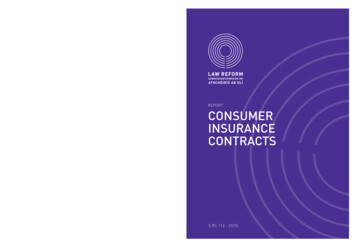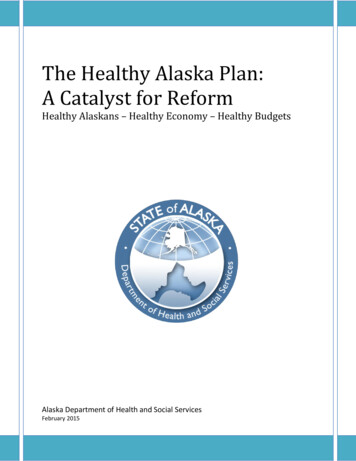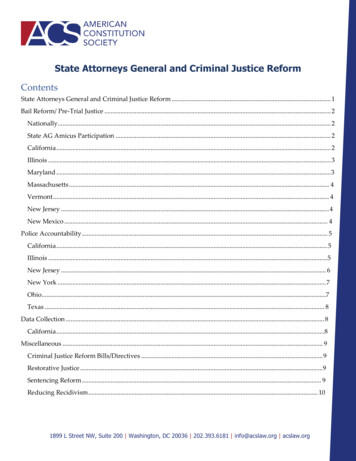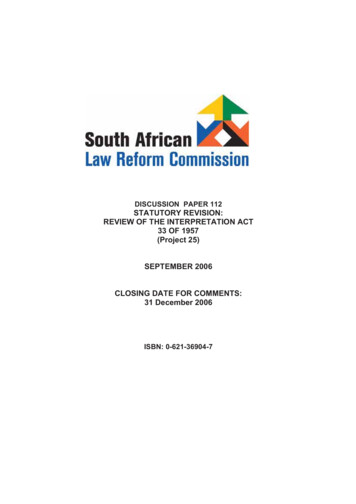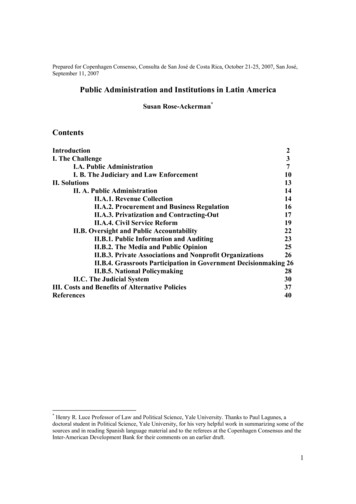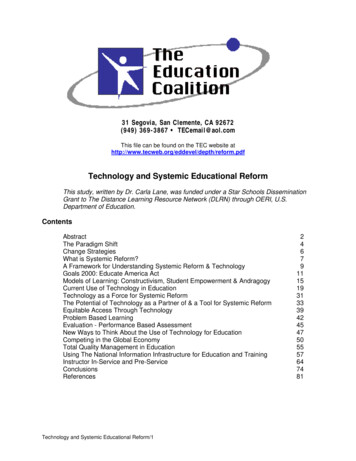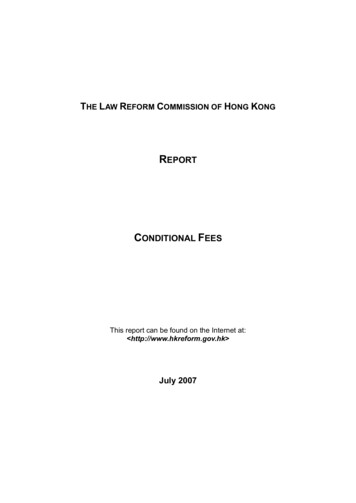
Transcription
THE LAW REFORM COMMISSION OF HONG KONGREPORTCONDITIONAL FEESThis report can be found on the Internet at: http://www.hkreform.gov.hk July 2007
The Law Reform Commission of Hong Kong was established by the ExecutiveCouncil in January 1980. The Commission considers for reform such aspectsof the law as may be referred to it by the Secretary for Justice or the ChiefJustice.The members of the Commission at present are:Chairman:Mr Wong Yan-lung, SC, Secretary for JusticeMembers:The Hon Mr Justice Andrew Li, Chief JusticeMr Tony Yen, SBS, JP, Law DraftsmanDr John Bacon-ShoneThe Hon Mr Justice Chan, PJProfessor Albert Chen, JPMr Anthony Chow, SBS, JPProfessor Y K Fan, BBS, JPProfessor Mike McConvilleMr Paul Shieh, SCMs Anna Wu, SBS, JPMr Benjamin Yu, SC, JPThe Secretary of the Commission is Mr Stuart M I Stoker and its offices are at:20/F Harcourt House39 Gloucester RoadWanchaiHong KongTelephone:Fax:E-mail:Website:2528 04722865 k
THE LAW REFORM COMMISSIONOF HONG KONGREPORTCONDITIONAL FEESCONTENTSChapterPagePreface1Terms of referenceThe Sub-committeeThe consultation exerciseConditional fees are not contingency feesTerminologyContingency feesConditional feesSpeculative feesOutcome-related feesLayout of this reportAcknowledgement112333344441.6The costs of litigationWho pays for litigation?Third party fundingRelevant costs rules in Hong KongCosts to follow the event – the costs indemnity ruleBases of taxation in Hong KongCosts on the party and party basisCosts on the common fund basisCosts on the indemnity basisCosts as between a solicitor and his own clientCosts on the trustee basisOther costs aspectsCounsel‟s feesCosts of litigant in personLegal aid as a source of finance for civil litigationThe merits testi68991111111112121313131414
ChapterPageThe means testOrdinary Legal Aid SchemeSupplementary Legal Aid SchemeCriminal Legal AidProvisions against conditional or contingency feearrangements in Hong Kong14151617182.Contingency fee arrangements in the USA20IntroductionThe percentage contingency feeCriticisms of contingency feesFrivolous litigationConflict of interestExcessive feesAdvantages of contingency feesOther unique features of the American civil justice systemCosts do not follow the eventTrial by juryPunitive damagesSpecialised plaintiff barPrecedents not bindingDiscoveryAbsence of legal aidClass actionsNon-specific pleadingsNew York 8283.29Legislative changes in England concerningconditional feesIntroductionMaintenance and champertyCriminal Law Act 1967Solicitors Act 1974The Royal Commission on Legal Services 1979Green Paper on Contingency Fees 1989Options set out in the 1989 Green PaperResponses to the 1989 Green PaperCourts and Legal Services Act 1990Conditional Fee Agreements Regulations 1995 andConditional Fee Agreements Order 1995After-the-event insuranceCounsel‟s feesEvaluation of conditional fee agreements in 1997Further reforms 1998 – 2000ii2929303232323333343437383840
ChapterPageConsultation Paper on “Access to Justice withConditional Fees” 1998Conditional Fee Agreements Order 1998Access to Justice Act 1999The Conditional Fee Agreements Regulations 2000General requirementsConditional fee agreements with a success feeInformation which must be given to a client beforemaking a conditional fee agreementCollective Conditional Fee Agreements Regulations 2000The Civil Procedure (Amendment No 4) Rules 2003 – Fixed costsConditional Fee Agreements (Miscellaneous Amendments)Regulations 2003DCA Consultation Paper June 2003Conditional Fee Agreements Forum 2003DCA Consultation Paper June 2004Civil Justice Council‟s Report August 2005Repeal of the Conditional Fee Agreements RegulationsThe use of conditional fee agreements in England404.58Problems and litigation in EnglandIntroductionLitigation on the recoverability of success fees and insurancepremiumsCallery v GrayThe jurisdiction issueThe prematurity issueCourt of Appeal decisionGovernment policyPolicy and practical considerationsThe House of Lords decisionReasonableness of the success feeCourt of Appeal decisionTwo-stage success feeThe House of Lords decisionReasonableness of the ATE premiumCourt of Appeal decisionThe House of Lords decisionComments on Callery v GrayHalloran v Delaney – from 20% success fee to 5%Comments on Halloran v DelaneyThe effect of BTE insurance on the recoverability of ATE premiumsSarwar v Alam – 2001Sarwar v Alam – 2003Re Claims Direct Test CasesThe position of outcome-related fee at common law andproblems with the costs indemnity 06062646465656767676868697070727374
ChapterPageBritish Waterways Board v NormanThe indemnity rulePublic policyAratra Potato Co Ltd v Taylor Joynson GarrettThai Trading Co v TaylorBevan Ashford v Yeandle LtdPost Thai Trading Co and Bevan Ashford decisionsCases not following Thai Trading CoHughes v Kingston-upon-Hull City CouncilAwwad v Geraghty & CoSignificance of Awwad after 1 November 2005Claims intermediariesEnglish v ClipsonThe scope of application of section 58 of the Court andLegal Services Act 1990R (Factortame Ltd) v Secretary of State for Transport,Local Government and the Regions (No 8)Hollins v RussellPost Hollins v RussellBowen v Bridgend County BCSamonini v London General Transport Services LtdGarbutt v EdwardsGarrett v Halton BC and Myatt v National Coal BoardOther recent technical challengesDefamation casesKing v Telegraph Group LtdTurcu v News Group Newspaper LtdCampbell v Mirror Group Newspaper LtdSummary of main ted fees in other jurisdictionsIntroductionAustralian jurisdictions – general observations and recent trendsLitigation funding companies, class actions andconditional feesOverview of conditional fees in Australian jurisdictionsMagic Menu Systems Pty Ltd v AFA Facilitation Pty LtdSmits v RoachLegal Practice Act 1996, VictoriaComments of the Law Institute of VictoriaLegal Profession Act 1987, New South WalesLegal expenses insurance in AustraliaCanadian jurisdictionsOntarioJoint Committee‟s proposed regulatory schemeIrelandMainland 103103105106107107109109
ChapterPageNorthern IrelandScotlandSpeculative feesConditional feesSouth Africa1111121121121136.115Arguments for and against conditional fees andrelated issuesIntroductionArguments against conditional feesThe risk of conflict of interest and unprofessional conductIncrease in opportunistic and frivolous claimsExcessive legal feesReliance on legal expenses insuranceSatellite litigationArguments in favour of conditional feesAccess to justiceSpread the financial risk involved in litigationWeed out frivolous or weak claimsAllow consumers to choose and promote freedom of contractAlign the lawyer‟s interests with those of the clientHarmonise the fee structure with other jurisdictionsOther related issuesClaims intermediariesRegulation of claims intermediaries in EnglandOperation of claims intermediaries in Hong KongInformation revealed at Legislative Council‟s Panel onAdministration of Justice and Legal ServicesRelevant regulations and rulesThe Administration‟s policy on claims intermediariesThe impact of allowing legal practitioners to chargeconditional fees on claims intermediariesLitigants in personSome statistics on litigants in personWhy litigants in person do not obtain legal representationOther surveys – Litigants in Person ProjectEarlier research by Camille Cameron and Elsa KellyAustralian Law Reform CommissionConsumer Council‟s Consumer Legal Action FundImpact on barristersProposals for 21221231241257.145Proposals for reformThe Sub-committee‟s consultation paperThe consultation 6
ChapterPageShould we allow conditional fees?Views on the proposed conditional fees regimeArguments advanced by those against the introduction ofconditional feesOur observationsAccess to justiceAccess to justice for the middle-income groupEnhanced access to justiceCounter-argumentsThe United Kingdom‟s House of Commons SelectCommittee on Constitutional AffairsATE insuranceProblems with ATE insurance in EnglandProspects of ATE insurance in Hong KongConditional fees without ATE insuranceExpansion of the Supplementary Legal Aid SchemeConsultees‟ responsesOur viewsSetting up of a privately-run conditional legal aid fundViews on a conditional legal aid fundEngland‟s Civil Justice Council‟s Report on “Improved Accessto Justice – Funding Options & Proportionate Costs”Other bodies in EnglandOur observationsFee arrangements for the proposed fund: conditional feesor normal fees?Should CLAF be run by the Legal Aid Department or should it berun independently?If insurers find conditional fees unpalatable, would CLAF(which utilises both conditional and contingency fees)be successful?Eligibility for CLAFCompetition between the schemesCompetition with the private sectorSmall and medium-sized enterprises and limited companiesThe merits testAppeal panelMediationBenefits of mediationAdverse costs order for unreasonable refusal to mediateProposed mechanismProper safeguardsJurisprudence in England and WalesMediation‟s interface with CLAFTypes of cases to be covered by CLAFAppealsContribution rate and 166167167167168169169170170172174174175
Chapter8.PageSummary of recommendationsAnnex176179Responses to Consultation Paper on Conditional Feesvii
PrefaceTerms of reference1.In May 2003, the Secretary for Justice and the Chief Justicedirected the Law Reform Commission:“To consider whether in the circumstances of Hong Kongconditional fee arrangements are feasible and should bepermitted for civil cases and, if so, to what extent (including forwhat types of cases and the features and limitations of any sucharrangements) and to recommend such changes in the law asmay be thought appropriate.”The Sub-committee2.The Sub-committee on Conditional Fees was appointed in July2003 to consider and advise on the present state of the law and to makeproposals for reform. The sub-committee members are:Prof Edward K Y Chen, GBS, CBE, JP(Chairman)PresidentLingnan UniversityMr William H P ChanDeputy DirectorLegal Aid DepartmentMrs Pamela W S Chan, BBS, JPFormer Chief ExecutiveConsumer CouncilMs Agnes H K Choi(from November 2005)General Manager and Head ofCorporate InsuranceHSBC Insurance (Asia-Pacific)Holdings LtdMr Andrew JeffriesPartnerAllen & Overy, SolicitorsMr Raymond Leung Hai-mingChief Executive OfficerC & L Investment Company LtdMr Raymond Leung Wai-manBarristerTemple Chambers1
Mr Kenneth S Y NgHead of Legal and ComplianceThe Hongkong and ShanghaiBanking Corporation LtdMr Peter Schelling(from February 2004to June 2005)Managing Director & CEOZurich Insurance Group(Hong Kong)Mr Michael ScottSenior Assistant Solicitor GeneralDepartment of JusticeMr Paul W T Shieh, SCSenior CounselTemple ChambersMs Sylvia W Y SiuConsultant SolicitorSit, Fung, Kwong & ShumMs Alice To Siu-kwan(from September 2003to February 2004)Assistant General ManagerTechnical Underwriting & ClaimsRoyal & Sun Alliance Insurance(HK) LtdThe Hon Madam Justice Yuen, JAJustice of AppealHigh CourtMr Byron T W Leung(Secretary from December 2005to April 2006)Senior Government CounselLaw Reform CommissionMs Cathy Wan(Secretary except fromDecember 2005 to April 2006)Senior Government CounselLaw Reform Commission3.The reference has been considered by the Sub-committee andthe Commission over the course of 18 meetings between July 2003 and May2007. In addition, views were exchanged within the Sub-committee at anumber of informal meetings and through correspondence.The consultation exercise4.In September 2005, the Sub-committee issued a consultationpaper to seek views and comments from the community. Over 80 writtenresponses were received and many of these were very substantial.Individuals and organisations that responded in writing are listed in the Annex.We wish to thank these individuals and organisations for their views and theircontribution to this law reform project.2
Conditional fees are not contingency fees5.From the responses received by the Sub-committee, it appearsthat members of the public sometimes confuse conditional fees asimplemented in England and Australian jurisdictions with contingency fees asimplemented in American jurisdictions.6.Briefly, conditional fees are based on the traditional basis ofcalculation of legal fees; the difference is that, if the civil lawsuit is lost, then nolegal fee will be charged, whereas if the civil lawsuit is won, then an additionalpercentage of the traditional legal fees will be charged. In contrast,contingency fees are based on the amount of compensation recovered from acivil lawsuit. If the civil lawsuit is lost, no legal fee will be charged, whereas ifthe civil lawsuit is won, then a percentage of the compensation recovered willbe charged as legal fees.7.The public‟s confusion of the two types of fees is understandable,given that the relevant terms are not used in a consistent manner in legalliterature.TerminologyContingency fees8.In some literature1 the term “contingency fees” is given a widemeaning and includes any type of calculation on a “no win, no fee” basis.However, in other contexts, “contingency fees” are taken to mean “percentagefees”, whereby the lawyer‟s fees are calculated as a percentage of the amountawarded by the court. This is the basis adopted in the American jurisdictions.For the purposes of this paper, we use the term “contingency fees” to meanonly “percentage fees”.Conditional fees9.The term “conditional fees” is also sometimes loosely used toinclude contingency fees. However, in other contexts, and also for thepurposes of this paper, “conditional fees” mean fee arrangements whereby, inthe event of success, the lawyer charges his usual fees plus an agreed flatamount or percentage “uplift” on the usual fees. The additional fee is oftenreferred to as an “uplift fee” or a “success fee”. Conditional fee agreementshave been allowed in the UK since 1995, and also in the Australianjurisdictions of Victoria, South Australia, New South Wales and Queensland.1For example, South African Law Commission, Report on Speculative and Contingency Fees,Project No 93, November 1996. Contrast, however, with Australian Law Reform Commission,Costs shifting – who pays for litigation (1995, Report No 75), footnote 20 on p 36, “Acontingency arrangement provides that, if the action succeeds, the lawyer receives the usualfee plus an agreed extra amount. If that amount is a flat amount or a percentage of the usualfee it is called an „uplift‟ contingency fee. If it is a percentage of the damages award it is calleda „percentage‟ contingency fee.”3
Speculative fees10.Where “speculative fees” are charged, the lawyer is entitled tocharge only his or her normal fees in the event of successful litigation. Wherethe action does not succeed, the lawyer is not entitled to a fee. Speculativefees have been used in Scotland for a long time.Outcome-related fees11.In this paper, “outcome-related fees” is used as a general term toinclude any fee arrangement between a legal practitioner and his or her clientin a civil litigation case whereby the legal fees payable would depend onwhether the case is successful or not. This basis of charging is sometimesalso referred to as “no win, no fee”, and would include contingency fees,conditional fees and speculative fees.12.An outcome-related fee arrangement is usually allowed only incivil litigation cases, although the scope of application differs amongstjurisdictions. In most jurisdictions, the costs indemnity rule applies, meaningthat the unsuccessful party has to pay the costs of the successful party. Anoutcome-related fee would not relieve the litigant from the risk of an adversecosts order to pay the other side‟s legal costs if the litigation is unsuccessful.Layout of this report13.The first chapter sets out the sources of litigation finance in HongKong, and the rules which apply to the allocation of costs. Chapter 2examines the application of contingency fees in the USA, while Chapters 3 and4 look at the development of conditional fees in England and recent problemsand litigation there. Chapter 5 turns to the experience of outcome-relatedfees in a number of other jurisdictions, and Chapter 6 deals with the argumentsfor and against conditional fees and sets out related issues for discussion.The Commission‟s recommendations are set out in Chapter 7, while Chapter 8contains a summary of the recommendations.Acknowledgement14.We wish to express our thanks to Mr Michael Napier, CBE(Member of the Executive Committee) and Mr Robert Musgrove (ChiefExecutive) of England‟s Civil Justice Council, Professor Michael G Faure ofMaastricht University (The Netherlands), and Professor Dame Hazel Genn ofUniversity College London. They visited Hong Kong between July andSeptember 2006, and provided valuable views and information to themembers of the Sub-committee.4
15.We would also like to thank Professor Elsa Kelly of the ChineseUniversity of Hong Kong and her team in „The Litigants in Person Project‟2who kindly included a question on conditional fees in their survey.2The project is entitled “Investigation and Analysis of Issues Raised by Self-Representation inthe High Court of Hong Kong” (Project No CUHK1191/04 H (2004)[law]) which is fully supportedby a grant from the Research Grants Council of the HKSAR. See Chapter 6 for furtherdiscussion.5
Chapter 1The costs of litigationWho pays for litigation?1.1The costs of litigation in courts and tribunals are met from anumber of different sources. The principal sources of finance for litigation arediscussed below.11.2Insurance – Insurance companies are major participants inlitigation, particularly in personal injury cases, where the dispute usuallyconcerns the amount of damages rather than liability. In cases where thecourts order the defendant to pay the plaintiff‟s costs pursuant to the costsindemnity rule, 2 these costs are often paid by the defendant‟s insurancecompany in accordance with the insurance policy. In some jurisdictions,litigation costs are paid out of legal expense insurance schemes. These arecommon in Europe and in the United States, and growing in number in Canadaand the United Kingdom.3 In Sweden, for example, legal expense insurancewas introduced in 1961 and is now an obligatory part of householders‟comprehensive insurance. It is reported that 70% of Sweden‟s population isprotected by legal expense insurance, and 84% of total litigation costs are paidout of insurance. Such schemes provide cover to individuals for the costs oflitigation in the courts (but not tribunals) in relation to disputes that arise in theireveryday relations, except for divorce proceedings and disputes arising froman occupation for gain other than regular work.4 The cover indemnifies thelitigant for his own costs and those of the other party that the litigant might berequired to pay.51.3Legal aid – The Legal Aid Department in Hong Kong providesassistance to litigants who satisfy the relevant means and merits tests, if theirtype of case is covered by the legal aid schemes.6 The legal aid schemescover both criminal and civil cases, the latter mainly in relation to matrimonialdisputes, miscellaneous personal injury and running-down cases. In 2006,17,285 applications for civil legal aid were received and 9,229 of them weregranted. The Legal Aid Department‟s expenditure on civil cases was 303.1million that year, and 663.6 million was recovered for the aided persons. As123456The categorisation largely follows that of the Australian Law Reform Commission, Costsshifting – who pays for litigation (1995, Report No 75), at 35-40.The “costs indemnity rule” is discussed later in this chapter.Law Reform Commission of Victoria, The Cost of Litigation (May 1990), at 39.As above.As above.Legal aid in Hong Kong will be discussed in greater detail later in this chapter.6
for criminal legal aid, the same year recorded 3,779 applications, with 2,357 ofthem granted, for an expenditure of 113.8 million.71.4Tax deductions – The Australian Law Reform Commission (“theALRC”)8 pointed out that businesses are major users of the court system, andthat legal expenses incurred are generally tax deductible. The ALRC‟sconsultation exercise revealed that many people saw the tax deductionsavailable to business litigants as inherently inequitable because they were notalso available to individual litigants. The business litigant who does not haveto bear the full cost of litigation can therefore afford to engage more readily inlitigation, to prolong the litigation, and to hire more expensive representation.Individuals who qualify for legal aid must undergo a strict merits and meanstest, whereas business litigants are eligible for tax deductions without anyassessment of the merit or reasonableness of the legal expense.91.5Legal practitioners – In jurisdictions which allow outcome-relatedfees, the litigation costs of unsuccessful cases are borne by the legalpractitioners. The level of utilisation of outcome-related fees differs fromjurisdiction to jurisdiction. The ALRC observed10 that in Australia speculativeand conditional fee arrangements are commonly used by plaintiffs‟ lawyers inpersonal injury cases. They are also used, although less frequently, for otherclaims for damages. Occasionally they are used where non-monetary relief,such as a declaration or injunction, is sought. In Scotland, by contrast, it wasestimated that only about 1% of all cases are charged on a speculative basis. 11As for the United States, in the absence of legal aid, contingency fees are oneof the principal sources of financing for litigation.1.6Claims intermediaries – These are businesses run by non-legallyqualified persons that help clients handle their compensation claims, usuallythose arising from traffic or work-related accidents. They operate on a “nowin, no fee” basis, and usually require payment of 20% – 30% of thecompensation received if the claim is successful. Claims intermediaries haveproliferated in England, and are operating in Hong Kong. Given that thecommon law offences of maintenance and champerty are still applicable toHong Kong, in some circumstances the activities of claims intermediariesmight be unlawful. This issue will be discussed in greater detail in Chapter 6of this paper.1.7Litigants – The parties‟ own resources are the most obvioussource of finance for litigation. The costs rules determine which litigant shallpay how much, and the basis for determination of costs.7891011Figures provided by the Legal Aid Department.Report No 75 at 38-40.In answer to suggestions that individuals too should enjoy tax deduction for legal expenses, theALRC, however, has rightly pointed out that tax deductions are different in nature from othersources of litigation costs, and that the tax system is designed to meet economic and otherobjectives. It seems, therefore, the question whether individuals should enjoy tax deduction forlegal expenses requires more in-depth consideration.Report No 75 at 36.South African Law Commission, Report on Speculative and Contingency Fees (1996), atpara 2.17.7
1.8Third party funding – The use of funding by a third party hasbecome more prevalent in jurisdictions such as England and Australia. Someare commercial funders; although they are not party to the litigation, theysubstantially control it or stand to benefit from it on a contingency basis. Onthe other hand, there are “pure funders” who have been described as “thosewith no personal interest in the litigation, who do not stand to benefit from it,are not funding it as a matter of business, and in no way seek to control itscourse”.12 Since this form of funding is relatively new, it is discussed furtherbelow.Third party funding1.9The developing trend of third party funding has been examinedby England‟s Court of Appeal in Arkin v Borchard Lines Ltd.13 The claimant inthis case was impecunious and his lawyers acted on a conditional feearrangement with financial support provided by a professional funder to amaximum of 1.3 million, which was lost when the case failed. The costsincurred by the defendants came to almost 6 million. The Court of Appealconsidered the question as to whether an order of costs should be madeagainst a non-party on the ground that the non-party had supported theunsuccessful claimant.1.10The Court of Appeal examined Hamilton v Al-Fayed (No 2)14 inwhich Simon Brown LJ identified the conflict between the desirability of thefunded party gaining access to justice on the one hand, and the desirabilitythat the successful defendant should be able to recover his costs on the other.Simon Brown LJ recognised that the costs indemnity rule could deter thebringing of actions that were likely to be lost. The careful assessment oflawyers acting under conditional fee arrangements or the assessment of theLegal Services Commission granting legal aid were likely to achieve the samebenefit. However, “pure funders” 15 were less likely to exercise the samecareful judgment.1.11The Court of Appeal then considered the Privy Council decisionDymocks Franchise Systems (NSW) Pty Ltd v Todd 16 which set out theprinciples derived from English and Commonwealth authorities. The PrivyCouncil pointed out that, although costs orders against non-parties are to beregarded as “exceptional”, the ultimate question is whether in all thecircumstances it is just to make the order. Generally speaking, costs orders1213141516Hamilton v Al-Fayed (No 2) [2002] EWCA Civ 665, quoted in Privy Council decision DymocksFranchise Systems (NSW) Pty Ltd v Todd [2004] UK PC 39. In Hong Kong, Deputy JudgeSaunders (as he then was) considered the law of champerty and recognized in SiegfriedAdalbert Unruh v Hans-Joerg Seeberger & Anor, HCA 6641 of 2000 (unrep), 3rd September2004 that where a party has a commercial interest in the litigation of another person, it is notunlawful to fund that litigation. This ruling was affirmed on appeal to the Court of Appeal(CACV 298/2004, 7/10/2005) and further appeal to the Court of Final Appeal (FACV 9&10/2006,9/2/2007).[2005] EWCA Civ 655, [2005] 1 WLR 3055.[2002] EWCA Civ 665.See definition in para 1.8.[2004] UK PC 39.8
would not be made against “pure funders” as the court would give priority tothe public interest in the funded party getting access to justice. However, ifthe non-party does not merely fund the litigation but also substantially controlsit or stands to benefit from it, then justice will ordinarily require that, if theproceedings fail, he will pay the successful party‟s costs. The non-party hasbecome “the real party” to the litigation.1.12The Court of Appeal pointed out it would be unjust that a funderwho purchases a stake in an action for a commercial motive should beprotected from liability for the costs of the opposing party. The Court ofAppeal said that a just solution must be devised whereby on the one hand asuccessful opponent is not denied all his costs, while on the other handcommercial funders (who provide a service to those seeking access to justicewhich they could not otherwise afford) are not deterred by the fear ofdisproportionate costs consequences.1.13The Court of Appeal said that a professional funder should bepotentially liable for the costs of the opposing party to the extent of the fundingprovided. The Court of Appeal was aware that this might cause funders toseek a greater percentage from the compensation and thereby reduce the netrecovery of successful claimants. However, overall justice would be betterserved than leaving defendants in a position where they had no right to recoverany costs from a funder whose intervention had enabled the continuation of aclaim which had proved to be without merit.1.14The Court of Appeal envisaged that this proposed course shouldcause commercial funders to cap the funds that they contribute to a particularlitigation in order to limit their exposure, and this should have a salutary effectin keeping costs proportionate.Relevant costs rules in Hong Kong1.15To assess the impact of the introduction of any outcome-relatedfees in Hong Kong, it is useful to set out an overview of the relevant costs rules.The word “costs” is sometimes used to denote the remuneration which a partypays to his own solicitor. It also means the sum of money which the courtorders one litigant to pay to another to compensate the latter for the expensewhich he has incurred in litigation. Relevant costs rules in Hong Kong arefound in Order 62 of the Rules of the High Court (Cap 4A), which applies tocontentious proceedings.17Costs to follow the event – the costs indemnity rule1.16If in the exercise of its discretion the Court sees fit to make anyorder as to the costs of, or incidental to, any proceedings, the Court will order17Subject to some exceptions. Order 60, r 2.9
the costs “to follow the event”,18 except when it appears that some other ordershould be made as to the whole or any part of the costs. This means that theunsuccessful litigant will usually be ordered to pay the legal costs of thesuccessful party,19 in addition to paying his own legal costs. This rule isreferred to as the “costs indemnity rule”, 20 and is also the basic costsallocation rule for civil proceedings in the United Kingdom, Canada, Japan andmost European countries. 21 The principal exception is the United States,where the general rule is that each party must pay his or her own costs, exceptwhere the litigation is vexatious or an abuse of process.221.17Considerations which justify the costs indemnity rule are that it: deters vexatious, frivolous or unmeritorious claims or defences;23compensates successful litigants for at
of the law as may be referred to it by the Secretary for Justice or the Chief Justice. The members of the Commission at present are: Chairman: Mr Wong Yan-lung, SC, Secretary for Justice . Members: The Hon Mr Justice Andrew Li, Chief Justice . Mr Tony Yen, SBS, JP, Law Draftsman . Dr John Bacon-Shone . The Hon Mr Justice Chan, PJ




